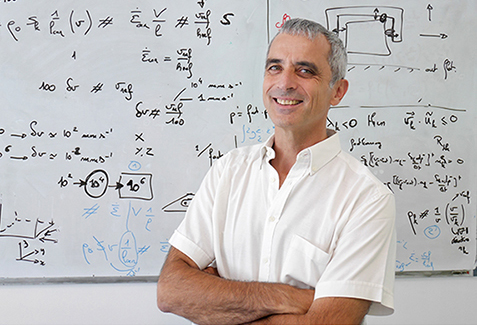Theme: Research
PhD Defence of Sebastian Florez
Sebastian Florez defends his PhD in Numerical Mechanics and Materials on Nov. 30th, 2020.
"Towards highly efficient massive-multidomain simulations in the context of microstructural evolutions"
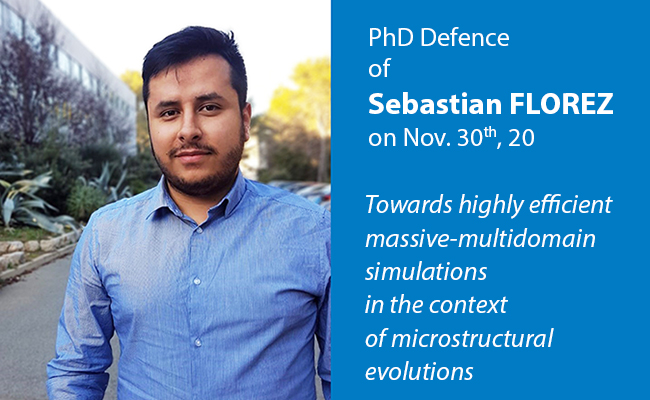
Sebastian Florez conducted his PhD work in MSR team, under the supervision of Marc Bernacki. He defends his work in front of the following jury:
Abstract of his work:
Strategic industries make extensive use of metallic materials. Today, there is a strong demand from these industries to predict, during hot metal forming processes, the microstructural evolutions of these materials, which are of prime importance concerning their final in-use properties.

PhD defence of David Ruiz
David Ruiz defends his PhD in Numerical Mechanics and Materials on Dec. 7th, 2020.
"Full field modeling of discontinuous dynamic recrystallization in a CPFEM context"
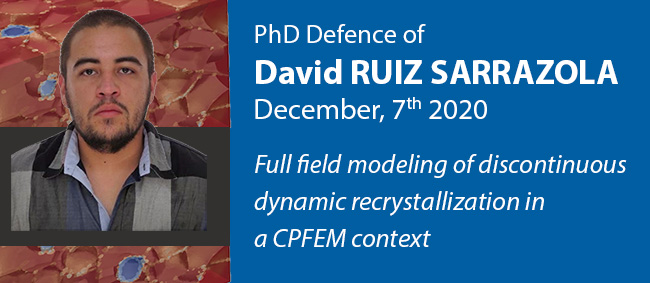
David Ruiz Sarrazola conducted his PhD work under the supervision of Marc Bernacki (MSR team) in the framewwork of the Industrial ANR Chair DIGIMU.
He will defend his thesis work in Numerical Mechanics and Materials in front of this jury:
– Pr. Laurent DELANNAY (Univ. Catholique de Louvain, Louvain-la-Neuve, Belgique)
– Pr. Lukasz MADEJ (AGH Univ. of Science and Tech., Krakow, Pologne)
– Assoc. Prof. Roland LOGÉ (Ecole Polytechnique Fédérale de Lausanne, Lausanne, Suisse)
– Pr. Javier SIGNORELLI (Inst. de Fisica Rosario, Santa Fé, Argentine)
– Privat Dozen Franz ROTERS (Max-Planck-Institut für Eisenforschung, Düsseldorf, Allemagne)
– M.R. Daniel PINO MUÑOZ (MINES ParisTech-CEMEF, Sophia Antipolis)
– C.R. Aurore MONTOUCHET (Framatome Creusot, Le Creusot)
Abstract of his work:
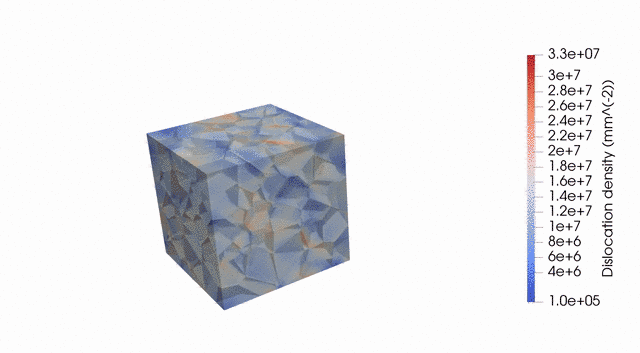
PhD Defence of Shitij Arora
Shitij Arora defends his PhD in Numerical Mechanics and Marerials on Nov. 24th, 2020.
His PhD : Steady-state formulation of metal forming processes: Contact coupling and treatment of history-dependent material models with unstructured meshes
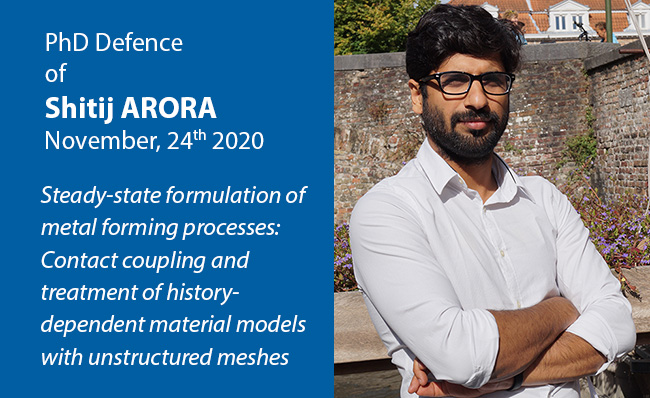
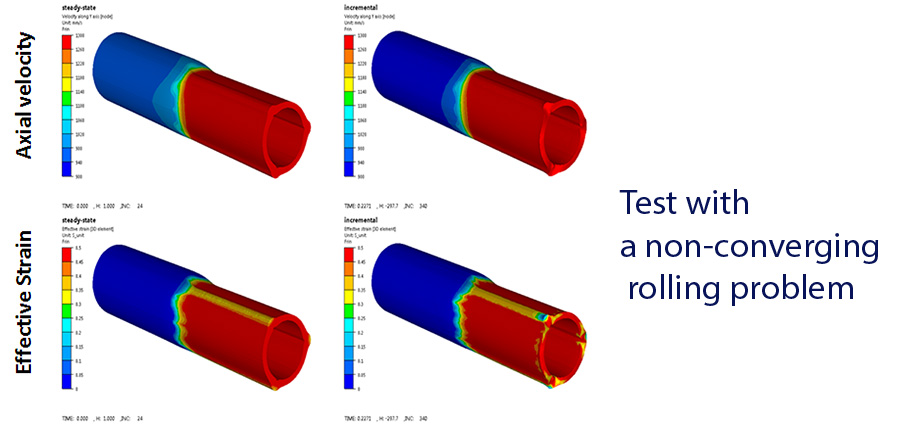
Loss of our colleague and friend, Lionel Fourment
It is with a great sadness that we learned of the passing on November 30th of our dear friend and colleague Lionel Fourment.
Lionel was a long-time colleague. He had been in the lab. for over thirty years.He joined CEMEF in 1987 and defended in 1992 his PhD work – prepared under the supervision of Jean-loup Chenot – on the topic of "Error estimators and adaptative meshing for computational modelling of forming processes". He spent his entire research career in our lab. He joined CNRS (French National Research Centre for Scientific Research) in 1994 and focused his research activities on the development of numerical methods in solid mechanics: Optimization and identification methods, error estimators, adaptative meshing, solving methods for large linear systems, computation time reduction, parallel computation, contact problems and more recently development of numerical methods for ALE formulation, stationary problems in elastoplasticity. He carried out in-depth investigation on these topics. And we can clearly say that he was one of the key players in the numerical methods developments on our lab. His contributions to the outreach and visibility of CEMEF's scientific production have gone far beyond our laboratory.
PhD Defence of Luiz Pereira
Luiz Pereira defends his PhD in Numerical Mechanics and Marerials on Nov. 12th, 2020.
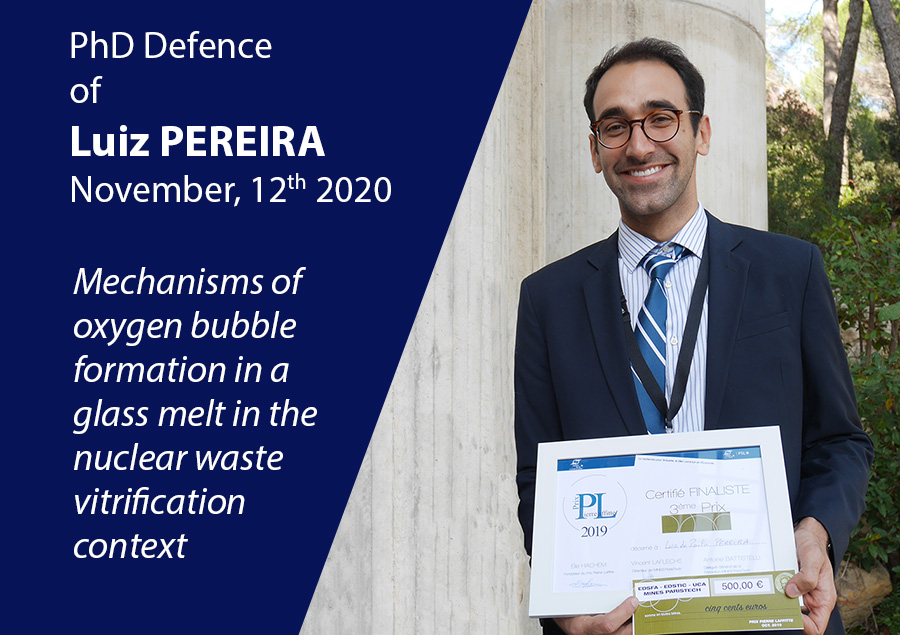
He worked on the mechanisms of oxygen bubble formation in a glass melt in the nuclear waste vitrification context.
His thesis was supervised by Franck Pigeonneau, CFL team in the framework of a project with CEA.
Abstract of his work:
- Oxide melt
- Bubbles
- Redox reaction
- Experimental approach
- Numerical approach
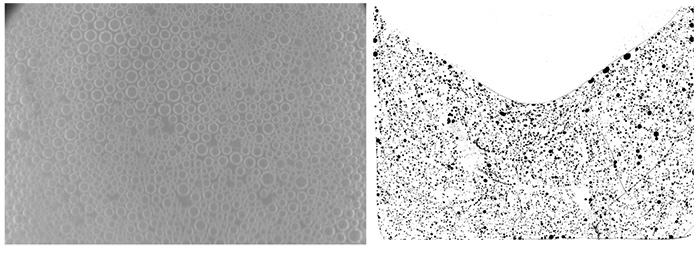
On the left, a population of bubbles in a borosilicate melt at 1200°c, in situ camera imaging device
On the right,a population of bubbles in a borosilicate melt at 1050°c, optical microscopy
Elie Hachem, distinguished 2020 IACM Fellow
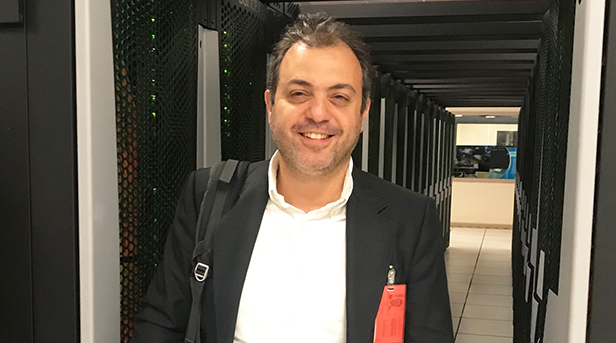
Elie Hachem, scientist at CEMEF, head of the CFL team, is distinguished IACM 2020 Fellow.
The IACM, the International Association for Computational Mechanics, is THE scientific society in the field of computational mechanics. It brings together more than 5,000 members worldwide. Every two years, it awards its prestigious Fellow Award.
This award recognizes up to 8 individuals who have distinguished themselves by their research achievements and publications in the fields of computational mechanics, and who have supported the IACM as members and by taking active part in its meetings and activities.
Elie Hachem talks about this award :
To be recognized by one's peers is always an immense satisfaction. But it goes beyond that. I am looking forward to joining this club that I have always admired. The IACM is THE international community for mechanics and numerical simulation. When I look at the list of winners, among them are my mentors. I think of C. Farhat and J.L. Chenot (former director of CEMEF) to name but a few, but there are many other researchers I admire. This means a lot to me.
I take this award as recognition of the work done, of course. It also strengthens France's position in this field of research. I am proud to contribute to it. It makes me even more motivated to continue to challenge myself and my team on a scientific level.
This prize also gives me a great responsibility. I hope to be able to inspire young people, to make them want to docomputational research.
>> Read more:
– Elie Hachem's latest publications


